Assessing the Impact of Culture on Organizational Dynamics
VerifiedAdded on 2020/07/23
|11
|3601
|25
Thesis and Dissertation
AI Summary
This dissertation chapter provides a comprehensive literature review on the impact of cultural diversification on business organizations. It begins with an introduction highlighting the importance of understanding cultural differences in a globalized economy, followed by an in-depth analysis of the existing literature. The review explores key concepts such as Hofstede's five-dimensional cultural theory, examining how cultural dimensions influence business activities, organizational structure, and employee relations. The chapter discusses the challenges and opportunities presented by cultural diversity, including issues like pricing difficulties, language problems, and cultural collisions. It also examines the impact of cultural forces, consumer decision-making processes, and cultural messages. The review further analyzes the impact of world cultural diversity on organizations, focusing on the role of management in handling cultural differences and creating a healthy and conducive working environment. The chapter concludes with an overview of Hofstede's cultural dimensions, providing insights into how these dimensions can be applied in international business and communication. The literature review incorporates various authors and their viewpoints, offering a detailed and insightful analysis of the subject matter.
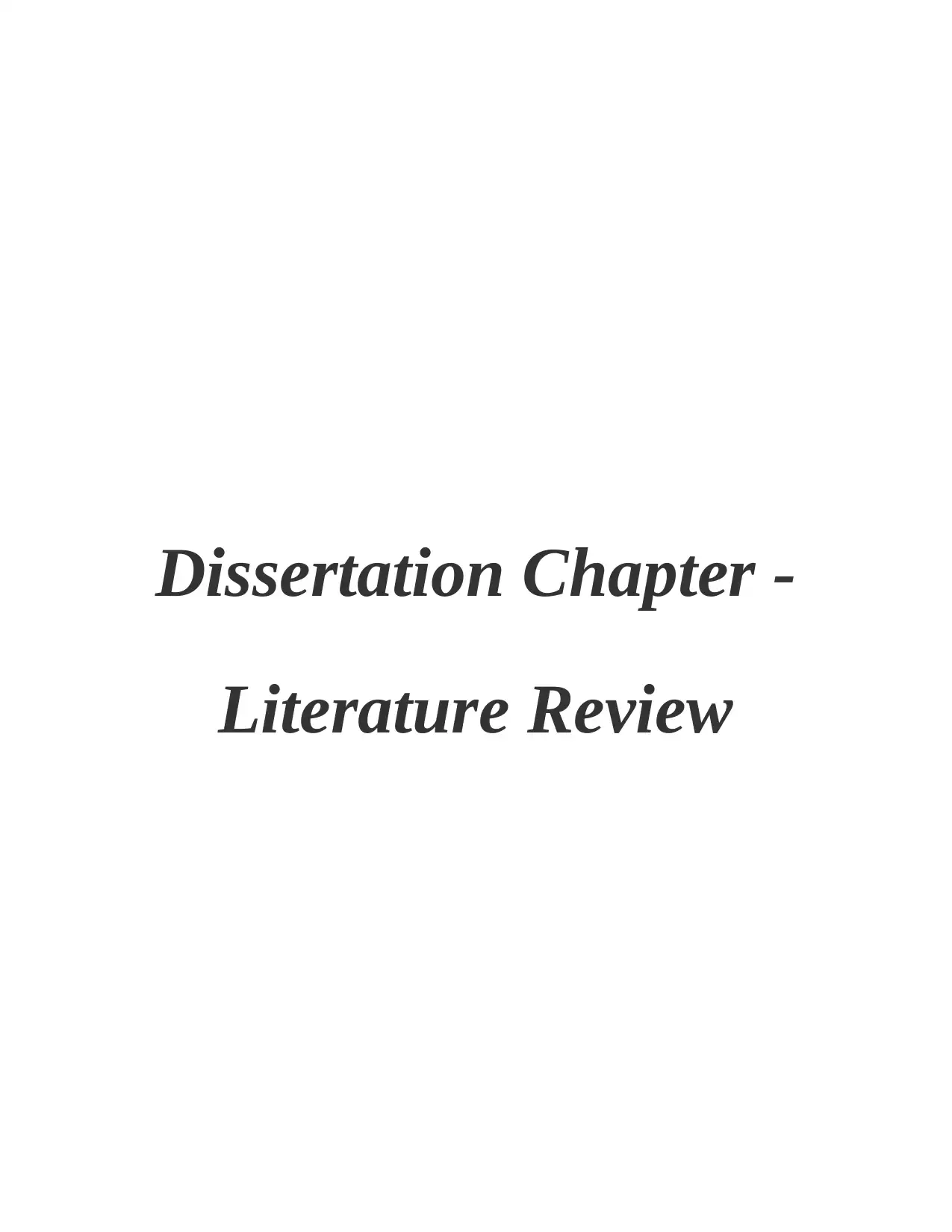
Dissertation Chapter -
Literature Review
Literature Review
Paraphrase This Document
Need a fresh take? Get an instant paraphrase of this document with our AI Paraphraser
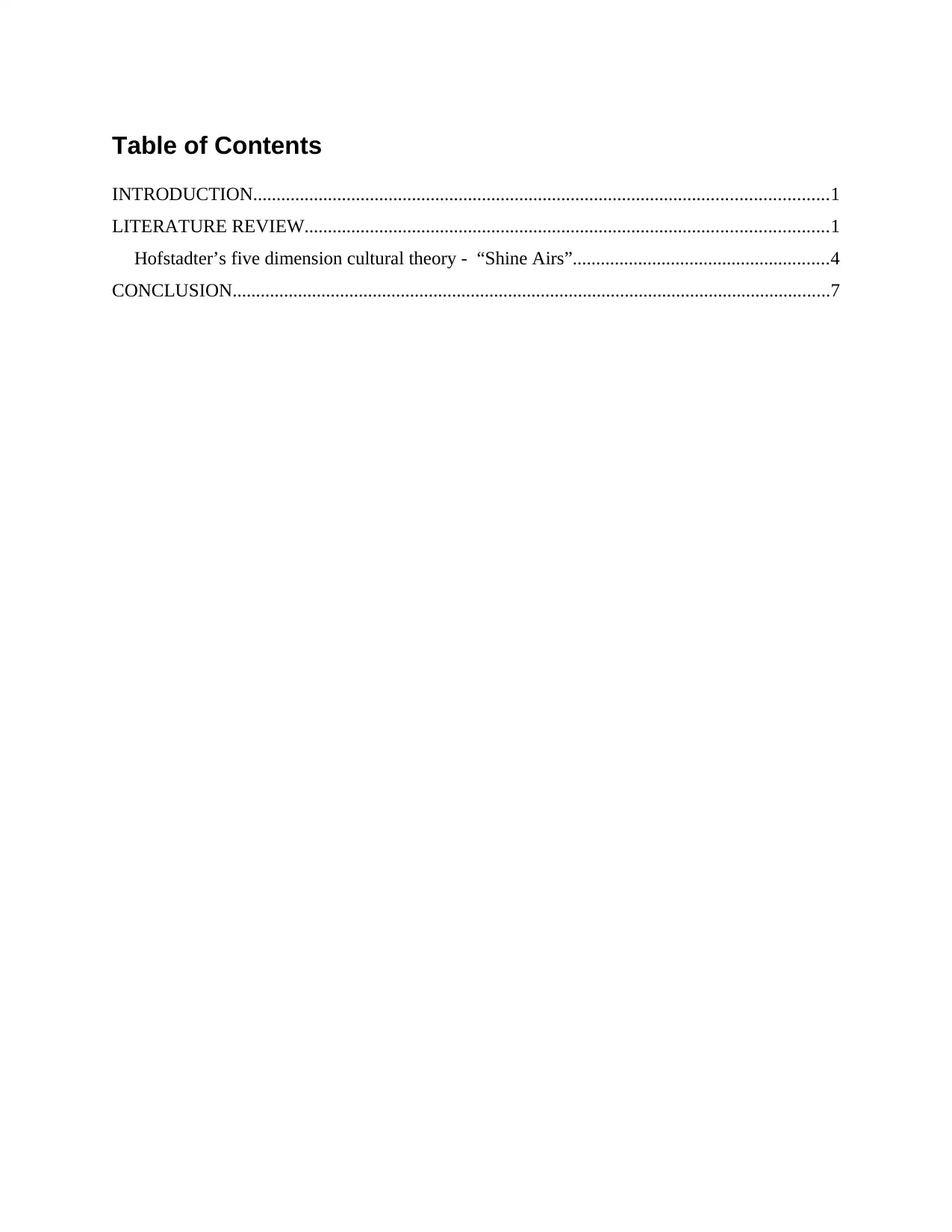
Table of Contents
INTRODUCTION...........................................................................................................................1
LITERATURE REVIEW................................................................................................................1
Hofstadter’s five dimension cultural theory - “Shine Airs”.......................................................4
CONCLUSION................................................................................................................................7
INTRODUCTION...........................................................................................................................1
LITERATURE REVIEW................................................................................................................1
Hofstadter’s five dimension cultural theory - “Shine Airs”.......................................................4
CONCLUSION................................................................................................................................7
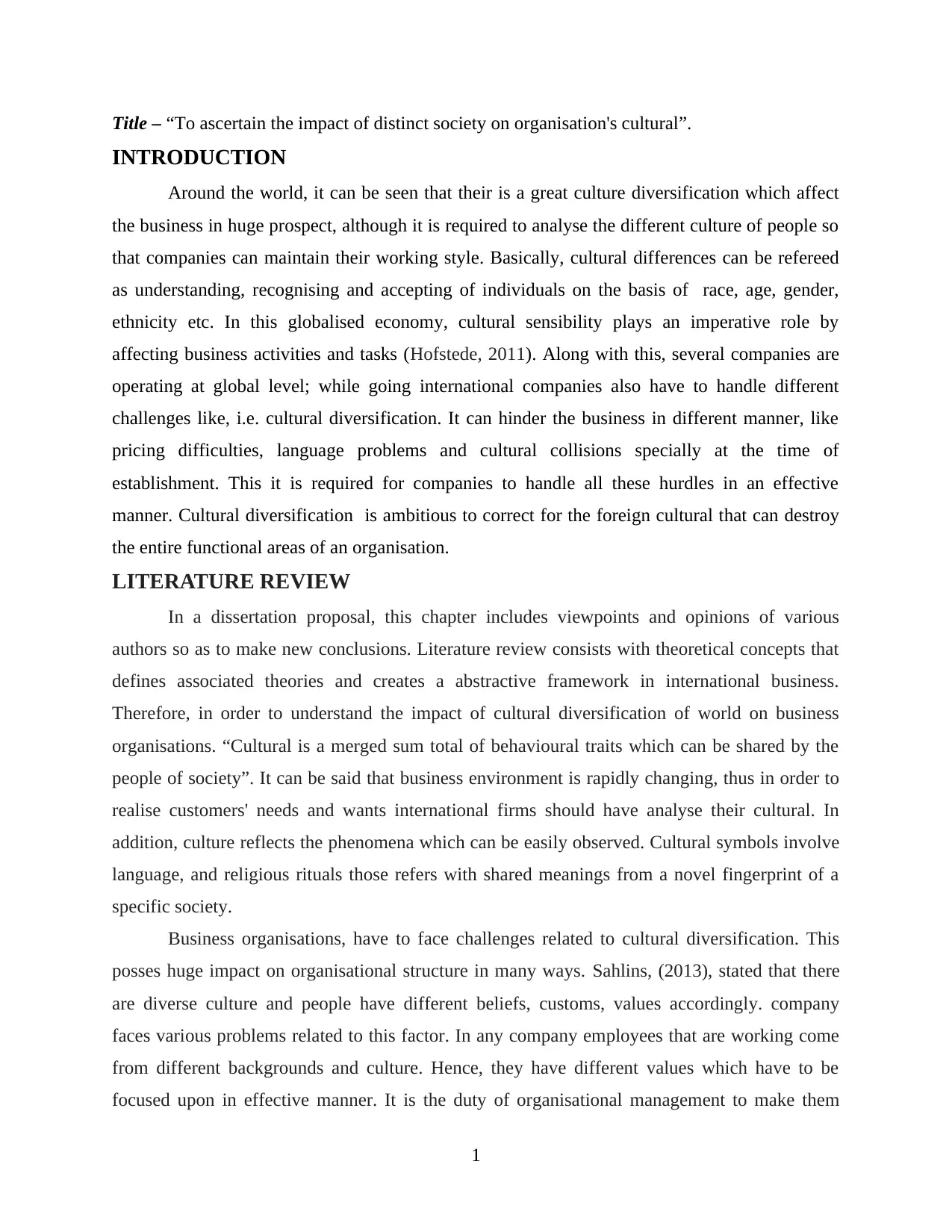
Title – “To ascertain the impact of distinct society on organisation's cultural”.
INTRODUCTION
Around the world, it can be seen that their is a great culture diversification which affect
the business in huge prospect, although it is required to analyse the different culture of people so
that companies can maintain their working style. Basically, cultural differences can be refereed
as understanding, recognising and accepting of individuals on the basis of race, age, gender,
ethnicity etc. In this globalised economy, cultural sensibility plays an imperative role by
affecting business activities and tasks (Hofstede, 2011). Along with this, several companies are
operating at global level; while going international companies also have to handle different
challenges like, i.e. cultural diversification. It can hinder the business in different manner, like
pricing difficulties, language problems and cultural collisions specially at the time of
establishment. This it is required for companies to handle all these hurdles in an effective
manner. Cultural diversification is ambitious to correct for the foreign cultural that can destroy
the entire functional areas of an organisation.
LITERATURE REVIEW
In a dissertation proposal, this chapter includes viewpoints and opinions of various
authors so as to make new conclusions. Literature review consists with theoretical concepts that
defines associated theories and creates a abstractive framework in international business.
Therefore, in order to understand the impact of cultural diversification of world on business
organisations. “Cultural is a merged sum total of behavioural traits which can be shared by the
people of society”. It can be said that business environment is rapidly changing, thus in order to
realise customers' needs and wants international firms should have analyse their cultural. In
addition, culture reflects the phenomena which can be easily observed. Cultural symbols involve
language, and religious rituals those refers with shared meanings from a novel fingerprint of a
specific society.
Business organisations, have to face challenges related to cultural diversification. This
posses huge impact on organisational structure in many ways. Sahlins, (2013), stated that there
are diverse culture and people have different beliefs, customs, values accordingly. company
faces various problems related to this factor. In any company employees that are working come
from different backgrounds and culture. Hence, they have different values which have to be
focused upon in effective manner. It is the duty of organisational management to make them
1
INTRODUCTION
Around the world, it can be seen that their is a great culture diversification which affect
the business in huge prospect, although it is required to analyse the different culture of people so
that companies can maintain their working style. Basically, cultural differences can be refereed
as understanding, recognising and accepting of individuals on the basis of race, age, gender,
ethnicity etc. In this globalised economy, cultural sensibility plays an imperative role by
affecting business activities and tasks (Hofstede, 2011). Along with this, several companies are
operating at global level; while going international companies also have to handle different
challenges like, i.e. cultural diversification. It can hinder the business in different manner, like
pricing difficulties, language problems and cultural collisions specially at the time of
establishment. This it is required for companies to handle all these hurdles in an effective
manner. Cultural diversification is ambitious to correct for the foreign cultural that can destroy
the entire functional areas of an organisation.
LITERATURE REVIEW
In a dissertation proposal, this chapter includes viewpoints and opinions of various
authors so as to make new conclusions. Literature review consists with theoretical concepts that
defines associated theories and creates a abstractive framework in international business.
Therefore, in order to understand the impact of cultural diversification of world on business
organisations. “Cultural is a merged sum total of behavioural traits which can be shared by the
people of society”. It can be said that business environment is rapidly changing, thus in order to
realise customers' needs and wants international firms should have analyse their cultural. In
addition, culture reflects the phenomena which can be easily observed. Cultural symbols involve
language, and religious rituals those refers with shared meanings from a novel fingerprint of a
specific society.
Business organisations, have to face challenges related to cultural diversification. This
posses huge impact on organisational structure in many ways. Sahlins, (2013), stated that there
are diverse culture and people have different beliefs, customs, values accordingly. company
faces various problems related to this factor. In any company employees that are working come
from different backgrounds and culture. Hence, they have different values which have to be
focused upon in effective manner. It is the duty of organisational management to make them
1
⊘ This is a preview!⊘
Do you want full access?
Subscribe today to unlock all pages.

Trusted by 1+ million students worldwide
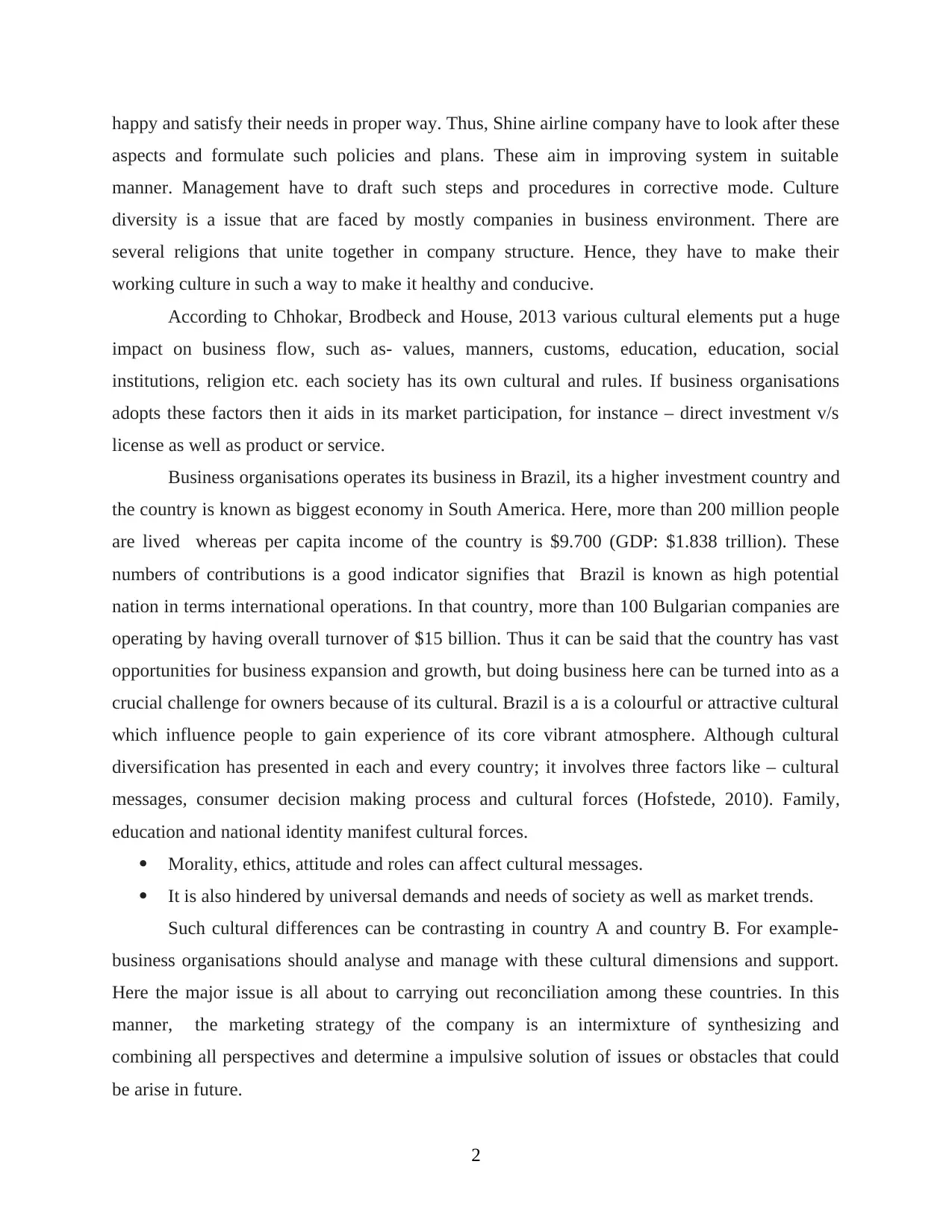
happy and satisfy their needs in proper way. Thus, Shine airline company have to look after these
aspects and formulate such policies and plans. These aim in improving system in suitable
manner. Management have to draft such steps and procedures in corrective mode. Culture
diversity is a issue that are faced by mostly companies in business environment. There are
several religions that unite together in company structure. Hence, they have to make their
working culture in such a way to make it healthy and conducive.
According to Chhokar, Brodbeck and House, 2013 various cultural elements put a huge
impact on business flow, such as- values, manners, customs, education, education, social
institutions, religion etc. each society has its own cultural and rules. If business organisations
adopts these factors then it aids in its market participation, for instance – direct investment v/s
license as well as product or service.
Business organisations operates its business in Brazil, its a higher investment country and
the country is known as biggest economy in South America. Here, more than 200 million people
are lived whereas per capita income of the country is $9.700 (GDP: $1.838 trillion). These
numbers of contributions is a good indicator signifies that Brazil is known as high potential
nation in terms international operations. In that country, more than 100 Bulgarian companies are
operating by having overall turnover of $15 billion. Thus it can be said that the country has vast
opportunities for business expansion and growth, but doing business here can be turned into as a
crucial challenge for owners because of its cultural. Brazil is a is a colourful or attractive cultural
which influence people to gain experience of its core vibrant atmosphere. Although cultural
diversification has presented in each and every country; it involves three factors like – cultural
messages, consumer decision making process and cultural forces (Hofstede, 2010). Family,
education and national identity manifest cultural forces.
Morality, ethics, attitude and roles can affect cultural messages.
It is also hindered by universal demands and needs of society as well as market trends.
Such cultural differences can be contrasting in country A and country B. For example-
business organisations should analyse and manage with these cultural dimensions and support.
Here the major issue is all about to carrying out reconciliation among these countries. In this
manner, the marketing strategy of the company is an intermixture of synthesizing and
combining all perspectives and determine a impulsive solution of issues or obstacles that could
be arise in future.
2
aspects and formulate such policies and plans. These aim in improving system in suitable
manner. Management have to draft such steps and procedures in corrective mode. Culture
diversity is a issue that are faced by mostly companies in business environment. There are
several religions that unite together in company structure. Hence, they have to make their
working culture in such a way to make it healthy and conducive.
According to Chhokar, Brodbeck and House, 2013 various cultural elements put a huge
impact on business flow, such as- values, manners, customs, education, education, social
institutions, religion etc. each society has its own cultural and rules. If business organisations
adopts these factors then it aids in its market participation, for instance – direct investment v/s
license as well as product or service.
Business organisations operates its business in Brazil, its a higher investment country and
the country is known as biggest economy in South America. Here, more than 200 million people
are lived whereas per capita income of the country is $9.700 (GDP: $1.838 trillion). These
numbers of contributions is a good indicator signifies that Brazil is known as high potential
nation in terms international operations. In that country, more than 100 Bulgarian companies are
operating by having overall turnover of $15 billion. Thus it can be said that the country has vast
opportunities for business expansion and growth, but doing business here can be turned into as a
crucial challenge for owners because of its cultural. Brazil is a is a colourful or attractive cultural
which influence people to gain experience of its core vibrant atmosphere. Although cultural
diversification has presented in each and every country; it involves three factors like – cultural
messages, consumer decision making process and cultural forces (Hofstede, 2010). Family,
education and national identity manifest cultural forces.
Morality, ethics, attitude and roles can affect cultural messages.
It is also hindered by universal demands and needs of society as well as market trends.
Such cultural differences can be contrasting in country A and country B. For example-
business organisations should analyse and manage with these cultural dimensions and support.
Here the major issue is all about to carrying out reconciliation among these countries. In this
manner, the marketing strategy of the company is an intermixture of synthesizing and
combining all perspectives and determine a impulsive solution of issues or obstacles that could
be arise in future.
2
Paraphrase This Document
Need a fresh take? Get an instant paraphrase of this document with our AI Paraphraser
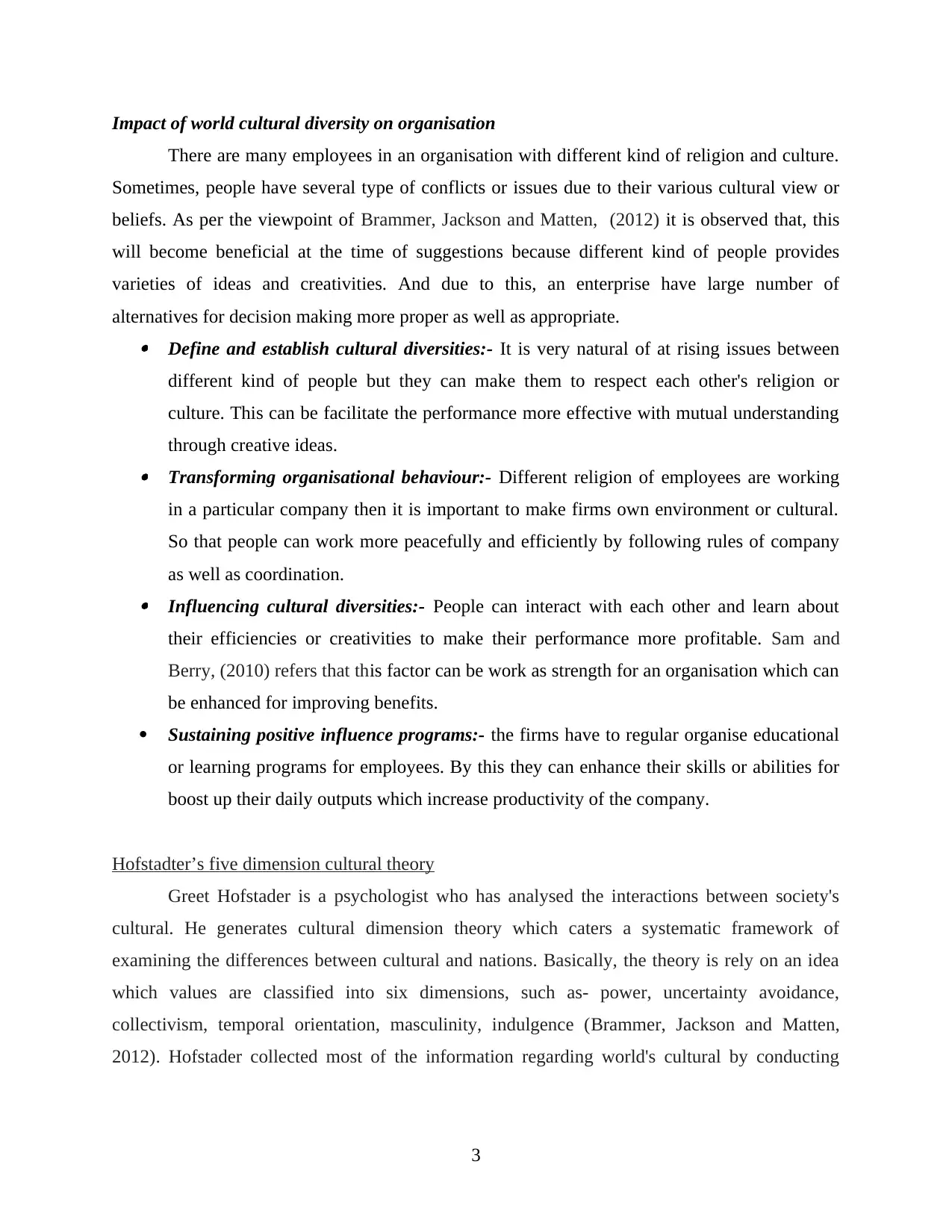
Impact of world cultural diversity on organisation
There are many employees in an organisation with different kind of religion and culture.
Sometimes, people have several type of conflicts or issues due to their various cultural view or
beliefs. As per the viewpoint of Brammer, Jackson and Matten, (2012) it is observed that, this
will become beneficial at the time of suggestions because different kind of people provides
varieties of ideas and creativities. And due to this, an enterprise have large number of
alternatives for decision making more proper as well as appropriate. Define and establish cultural diversities:- It is very natural of at rising issues between
different kind of people but they can make them to respect each other's religion or
culture. This can be facilitate the performance more effective with mutual understanding
through creative ideas. Transforming organisational behaviour:- Different religion of employees are working
in a particular company then it is important to make firms own environment or cultural.
So that people can work more peacefully and efficiently by following rules of company
as well as coordination. Influencing cultural diversities:- People can interact with each other and learn about
their efficiencies or creativities to make their performance more profitable. Sam and
Berry, (2010) refers that this factor can be work as strength for an organisation which can
be enhanced for improving benefits.
Sustaining positive influence programs:- the firms have to regular organise educational
or learning programs for employees. By this they can enhance their skills or abilities for
boost up their daily outputs which increase productivity of the company.
Hofstadter’s five dimension cultural theory
Greet Hofstader is a psychologist who has analysed the interactions between society's
cultural. He generates cultural dimension theory which caters a systematic framework of
examining the differences between cultural and nations. Basically, the theory is rely on an idea
which values are classified into six dimensions, such as- power, uncertainty avoidance,
collectivism, temporal orientation, masculinity, indulgence (Brammer, Jackson and Matten,
2012). Hofstader collected most of the information regarding world's cultural by conducting
3
There are many employees in an organisation with different kind of religion and culture.
Sometimes, people have several type of conflicts or issues due to their various cultural view or
beliefs. As per the viewpoint of Brammer, Jackson and Matten, (2012) it is observed that, this
will become beneficial at the time of suggestions because different kind of people provides
varieties of ideas and creativities. And due to this, an enterprise have large number of
alternatives for decision making more proper as well as appropriate. Define and establish cultural diversities:- It is very natural of at rising issues between
different kind of people but they can make them to respect each other's religion or
culture. This can be facilitate the performance more effective with mutual understanding
through creative ideas. Transforming organisational behaviour:- Different religion of employees are working
in a particular company then it is important to make firms own environment or cultural.
So that people can work more peacefully and efficiently by following rules of company
as well as coordination. Influencing cultural diversities:- People can interact with each other and learn about
their efficiencies or creativities to make their performance more profitable. Sam and
Berry, (2010) refers that this factor can be work as strength for an organisation which can
be enhanced for improving benefits.
Sustaining positive influence programs:- the firms have to regular organise educational
or learning programs for employees. By this they can enhance their skills or abilities for
boost up their daily outputs which increase productivity of the company.
Hofstadter’s five dimension cultural theory
Greet Hofstader is a psychologist who has analysed the interactions between society's
cultural. He generates cultural dimension theory which caters a systematic framework of
examining the differences between cultural and nations. Basically, the theory is rely on an idea
which values are classified into six dimensions, such as- power, uncertainty avoidance,
collectivism, temporal orientation, masculinity, indulgence (Brammer, Jackson and Matten,
2012). Hofstader collected most of the information regarding world's cultural by conducting
3
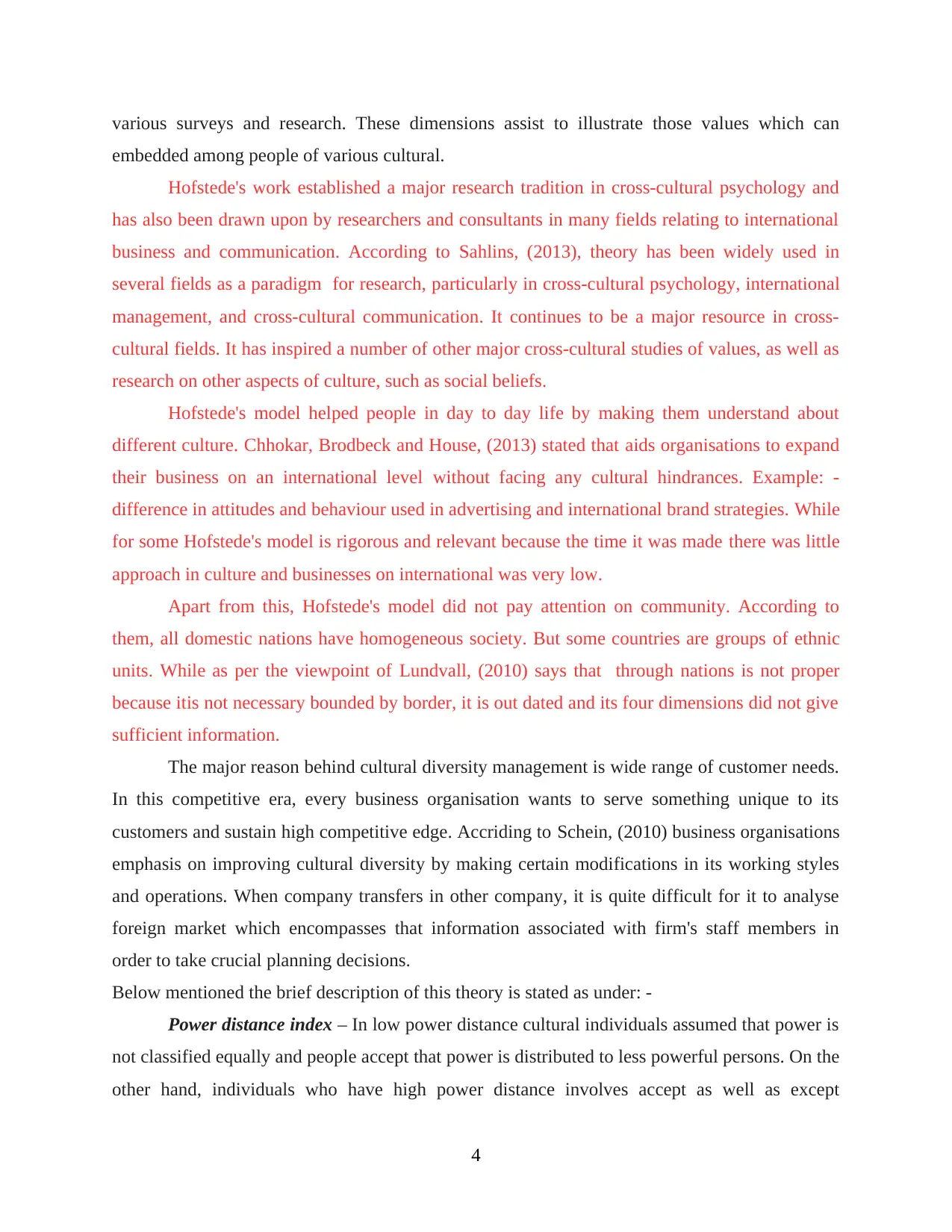
various surveys and research. These dimensions assist to illustrate those values which can
embedded among people of various cultural.
Hofstede's work established a major research tradition in cross-cultural psychology and
has also been drawn upon by researchers and consultants in many fields relating to international
business and communication. According to Sahlins, (2013), theory has been widely used in
several fields as a paradigm for research, particularly in cross-cultural psychology, international
management, and cross-cultural communication. It continues to be a major resource in cross-
cultural fields. It has inspired a number of other major cross-cultural studies of values, as well as
research on other aspects of culture, such as social beliefs.
Hofstede's model helped people in day to day life by making them understand about
different culture. Chhokar, Brodbeck and House, (2013) stated that aids organisations to expand
their business on an international level without facing any cultural hindrances. Example: -
difference in attitudes and behaviour used in advertising and international brand strategies. While
for some Hofstede's model is rigorous and relevant because the time it was made there was little
approach in culture and businesses on international was very low.
Apart from this, Hofstede's model did not pay attention on community. According to
them, all domestic nations have homogeneous society. But some countries are groups of ethnic
units. While as per the viewpoint of Lundvall, (2010) says that through nations is not proper
because itis not necessary bounded by border, it is out dated and its four dimensions did not give
sufficient information.
The major reason behind cultural diversity management is wide range of customer needs.
In this competitive era, every business organisation wants to serve something unique to its
customers and sustain high competitive edge. Accriding to Schein, (2010) business organisations
emphasis on improving cultural diversity by making certain modifications in its working styles
and operations. When company transfers in other company, it is quite difficult for it to analyse
foreign market which encompasses that information associated with firm's staff members in
order to take crucial planning decisions.
Below mentioned the brief description of this theory is stated as under: -
Power distance index – In low power distance cultural individuals assumed that power is
not classified equally and people accept that power is distributed to less powerful persons. On the
other hand, individuals who have high power distance involves accept as well as except
4
embedded among people of various cultural.
Hofstede's work established a major research tradition in cross-cultural psychology and
has also been drawn upon by researchers and consultants in many fields relating to international
business and communication. According to Sahlins, (2013), theory has been widely used in
several fields as a paradigm for research, particularly in cross-cultural psychology, international
management, and cross-cultural communication. It continues to be a major resource in cross-
cultural fields. It has inspired a number of other major cross-cultural studies of values, as well as
research on other aspects of culture, such as social beliefs.
Hofstede's model helped people in day to day life by making them understand about
different culture. Chhokar, Brodbeck and House, (2013) stated that aids organisations to expand
their business on an international level without facing any cultural hindrances. Example: -
difference in attitudes and behaviour used in advertising and international brand strategies. While
for some Hofstede's model is rigorous and relevant because the time it was made there was little
approach in culture and businesses on international was very low.
Apart from this, Hofstede's model did not pay attention on community. According to
them, all domestic nations have homogeneous society. But some countries are groups of ethnic
units. While as per the viewpoint of Lundvall, (2010) says that through nations is not proper
because itis not necessary bounded by border, it is out dated and its four dimensions did not give
sufficient information.
The major reason behind cultural diversity management is wide range of customer needs.
In this competitive era, every business organisation wants to serve something unique to its
customers and sustain high competitive edge. Accriding to Schein, (2010) business organisations
emphasis on improving cultural diversity by making certain modifications in its working styles
and operations. When company transfers in other company, it is quite difficult for it to analyse
foreign market which encompasses that information associated with firm's staff members in
order to take crucial planning decisions.
Below mentioned the brief description of this theory is stated as under: -
Power distance index – In low power distance cultural individuals assumed that power is
not classified equally and people accept that power is distributed to less powerful persons. On the
other hand, individuals who have high power distance involves accept as well as except
4
⊘ This is a preview!⊘
Do you want full access?
Subscribe today to unlock all pages.

Trusted by 1+ million students worldwide
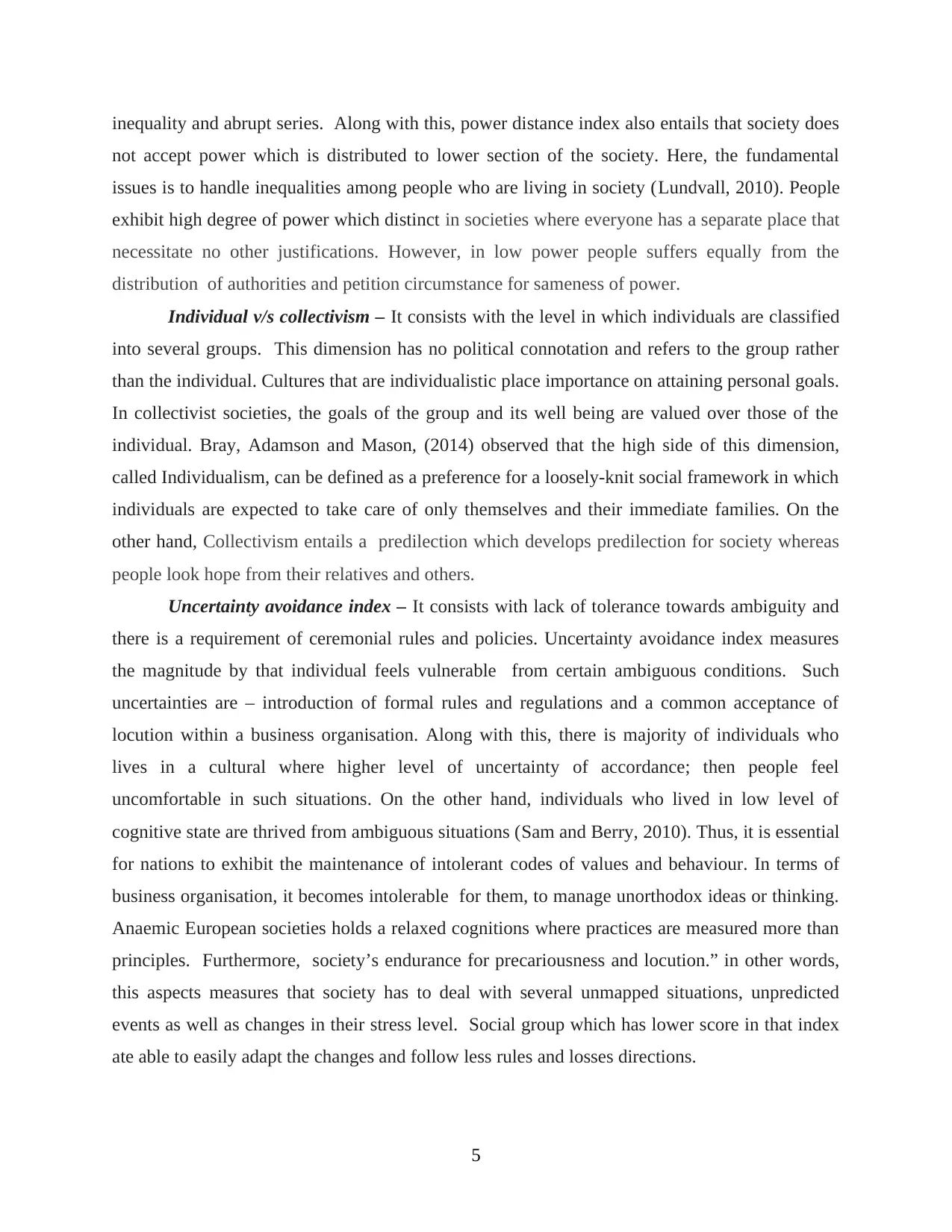
inequality and abrupt series. Along with this, power distance index also entails that society does
not accept power which is distributed to lower section of the society. Here, the fundamental
issues is to handle inequalities among people who are living in society (Lundvall, 2010). People
exhibit high degree of power which distinct in societies where everyone has a separate place that
necessitate no other justifications. However, in low power people suffers equally from the
distribution of authorities and petition circumstance for sameness of power.
Individual v/s collectivism – It consists with the level in which individuals are classified
into several groups. This dimension has no political connotation and refers to the group rather
than the individual. Cultures that are individualistic place importance on attaining personal goals.
In collectivist societies, the goals of the group and its well being are valued over those of the
individual. Bray, Adamson and Mason, (2014) observed that the high side of this dimension,
called Individualism, can be defined as a preference for a loosely-knit social framework in which
individuals are expected to take care of only themselves and their immediate families. On the
other hand, Collectivism entails a predilection which develops predilection for society whereas
people look hope from their relatives and others.
Uncertainty avoidance index – It consists with lack of tolerance towards ambiguity and
there is a requirement of ceremonial rules and policies. Uncertainty avoidance index measures
the magnitude by that individual feels vulnerable from certain ambiguous conditions. Such
uncertainties are – introduction of formal rules and regulations and a common acceptance of
locution within a business organisation. Along with this, there is majority of individuals who
lives in a cultural where higher level of uncertainty of accordance; then people feel
uncomfortable in such situations. On the other hand, individuals who lived in low level of
cognitive state are thrived from ambiguous situations (Sam and Berry, 2010). Thus, it is essential
for nations to exhibit the maintenance of intolerant codes of values and behaviour. In terms of
business organisation, it becomes intolerable for them, to manage unorthodox ideas or thinking.
Anaemic European societies holds a relaxed cognitions where practices are measured more than
principles. Furthermore, society’s endurance for precariousness and locution.” in other words,
this aspects measures that society has to deal with several unmapped situations, unpredicted
events as well as changes in their stress level. Social group which has lower score in that index
ate able to easily adapt the changes and follow less rules and losses directions.
5
not accept power which is distributed to lower section of the society. Here, the fundamental
issues is to handle inequalities among people who are living in society (Lundvall, 2010). People
exhibit high degree of power which distinct in societies where everyone has a separate place that
necessitate no other justifications. However, in low power people suffers equally from the
distribution of authorities and petition circumstance for sameness of power.
Individual v/s collectivism – It consists with the level in which individuals are classified
into several groups. This dimension has no political connotation and refers to the group rather
than the individual. Cultures that are individualistic place importance on attaining personal goals.
In collectivist societies, the goals of the group and its well being are valued over those of the
individual. Bray, Adamson and Mason, (2014) observed that the high side of this dimension,
called Individualism, can be defined as a preference for a loosely-knit social framework in which
individuals are expected to take care of only themselves and their immediate families. On the
other hand, Collectivism entails a predilection which develops predilection for society whereas
people look hope from their relatives and others.
Uncertainty avoidance index – It consists with lack of tolerance towards ambiguity and
there is a requirement of ceremonial rules and policies. Uncertainty avoidance index measures
the magnitude by that individual feels vulnerable from certain ambiguous conditions. Such
uncertainties are – introduction of formal rules and regulations and a common acceptance of
locution within a business organisation. Along with this, there is majority of individuals who
lives in a cultural where higher level of uncertainty of accordance; then people feel
uncomfortable in such situations. On the other hand, individuals who lived in low level of
cognitive state are thrived from ambiguous situations (Sam and Berry, 2010). Thus, it is essential
for nations to exhibit the maintenance of intolerant codes of values and behaviour. In terms of
business organisation, it becomes intolerable for them, to manage unorthodox ideas or thinking.
Anaemic European societies holds a relaxed cognitions where practices are measured more than
principles. Furthermore, society’s endurance for precariousness and locution.” in other words,
this aspects measures that society has to deal with several unmapped situations, unpredicted
events as well as changes in their stress level. Social group which has lower score in that index
ate able to easily adapt the changes and follow less rules and losses directions.
5
Paraphrase This Document
Need a fresh take? Get an instant paraphrase of this document with our AI Paraphraser
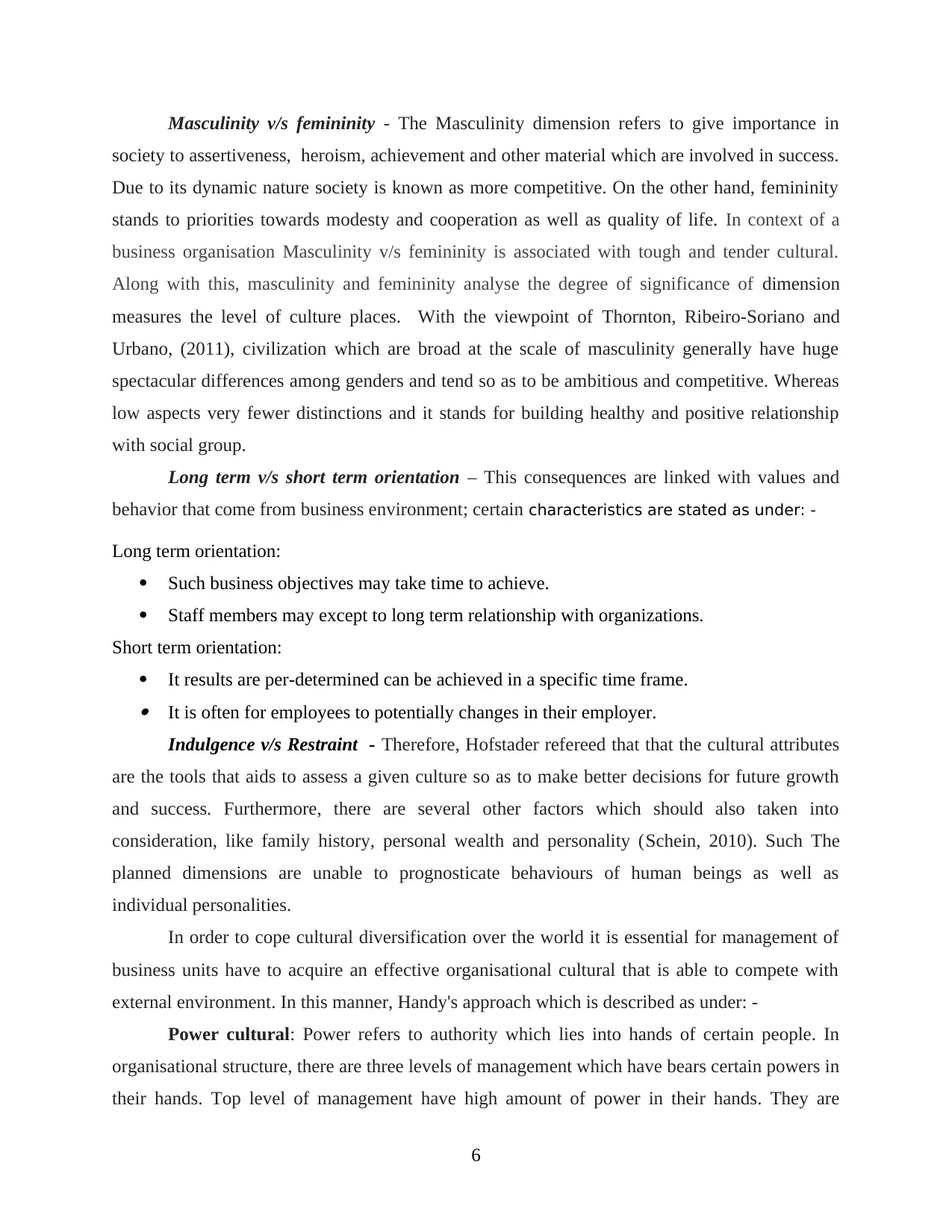
Masculinity v/s femininity - The Masculinity dimension refers to give importance in
society to assertiveness, heroism, achievement and other material which are involved in success.
Due to its dynamic nature society is known as more competitive. On the other hand, femininity
stands to priorities towards modesty and cooperation as well as quality of life. In context of a
business organisation Masculinity v/s femininity is associated with tough and tender cultural.
Along with this, masculinity and femininity analyse the degree of significance of dimension
measures the level of culture places. With the viewpoint of Thornton, Ribeiro-Soriano and
Urbano, (2011), civilization which are broad at the scale of masculinity generally have huge
spectacular differences among genders and tend so as to be ambitious and competitive. Whereas
low aspects very fewer distinctions and it stands for building healthy and positive relationship
with social group.
Long term v/s short term orientation – This consequences are linked with values and
behavior that come from business environment; certain characteristics are stated as under: -
Long term orientation:
Such business objectives may take time to achieve.
Staff members may except to long term relationship with organizations.
Short term orientation:
It results are per-determined can be achieved in a specific time frame. It is often for employees to potentially changes in their employer.
Indulgence v/s Restraint - Therefore, Hofstader refereed that that the cultural attributes
are the tools that aids to assess a given culture so as to make better decisions for future growth
and success. Furthermore, there are several other factors which should also taken into
consideration, like family history, personal wealth and personality (Schein, 2010). Such The
planned dimensions are unable to prognosticate behaviours of human beings as well as
individual personalities.
In order to cope cultural diversification over the world it is essential for management of
business units have to acquire an effective organisational cultural that is able to compete with
external environment. In this manner, Handy's approach which is described as under: -
Power cultural: Power refers to authority which lies into hands of certain people. In
organisational structure, there are three levels of management which have bears certain powers in
their hands. Top level of management have high amount of power in their hands. They are
6
society to assertiveness, heroism, achievement and other material which are involved in success.
Due to its dynamic nature society is known as more competitive. On the other hand, femininity
stands to priorities towards modesty and cooperation as well as quality of life. In context of a
business organisation Masculinity v/s femininity is associated with tough and tender cultural.
Along with this, masculinity and femininity analyse the degree of significance of dimension
measures the level of culture places. With the viewpoint of Thornton, Ribeiro-Soriano and
Urbano, (2011), civilization which are broad at the scale of masculinity generally have huge
spectacular differences among genders and tend so as to be ambitious and competitive. Whereas
low aspects very fewer distinctions and it stands for building healthy and positive relationship
with social group.
Long term v/s short term orientation – This consequences are linked with values and
behavior that come from business environment; certain characteristics are stated as under: -
Long term orientation:
Such business objectives may take time to achieve.
Staff members may except to long term relationship with organizations.
Short term orientation:
It results are per-determined can be achieved in a specific time frame. It is often for employees to potentially changes in their employer.
Indulgence v/s Restraint - Therefore, Hofstader refereed that that the cultural attributes
are the tools that aids to assess a given culture so as to make better decisions for future growth
and success. Furthermore, there are several other factors which should also taken into
consideration, like family history, personal wealth and personality (Schein, 2010). Such The
planned dimensions are unable to prognosticate behaviours of human beings as well as
individual personalities.
In order to cope cultural diversification over the world it is essential for management of
business units have to acquire an effective organisational cultural that is able to compete with
external environment. In this manner, Handy's approach which is described as under: -
Power cultural: Power refers to authority which lies into hands of certain people. In
organisational structure, there are three levels of management which have bears certain powers in
their hands. Top level of management have high amount of power in their hands. They are
6
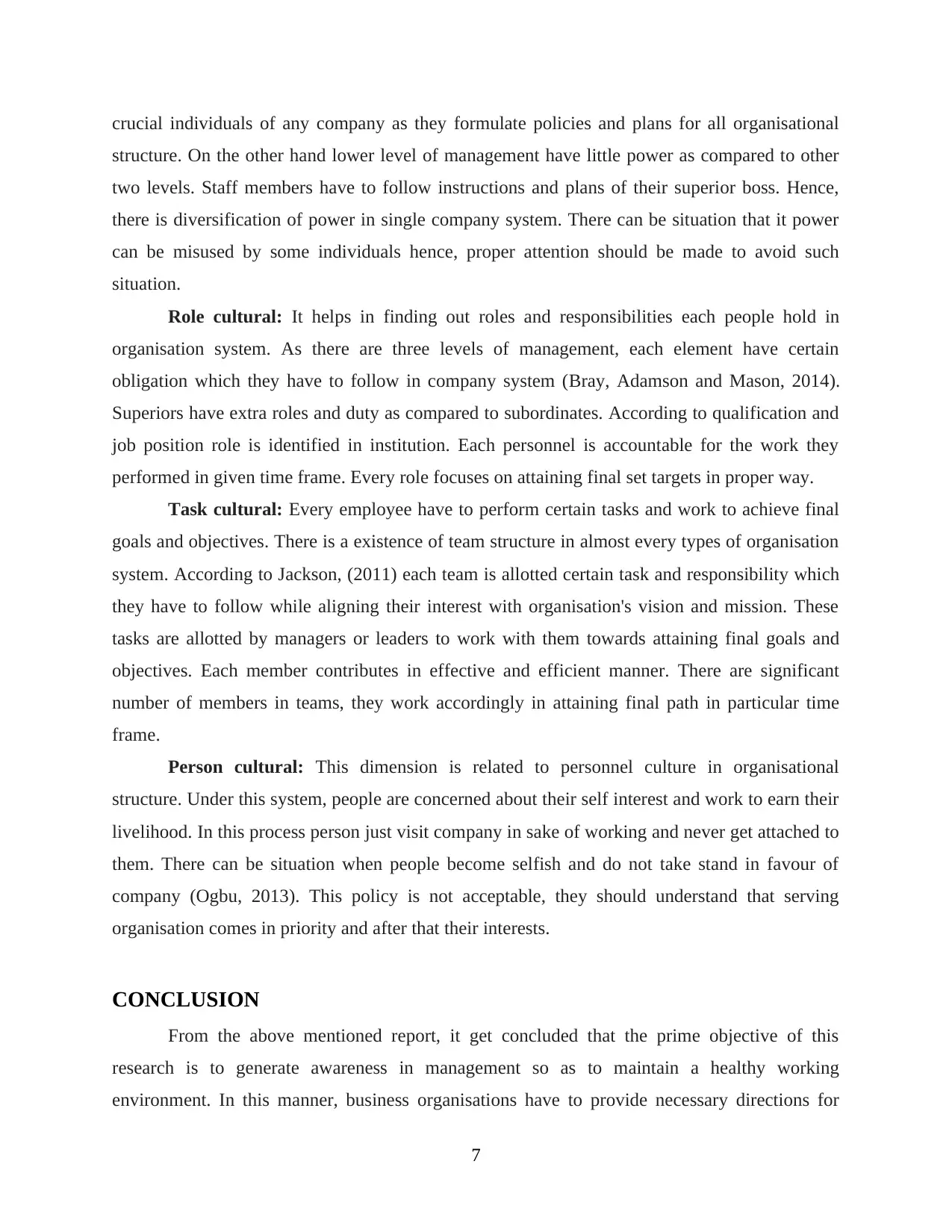
crucial individuals of any company as they formulate policies and plans for all organisational
structure. On the other hand lower level of management have little power as compared to other
two levels. Staff members have to follow instructions and plans of their superior boss. Hence,
there is diversification of power in single company system. There can be situation that it power
can be misused by some individuals hence, proper attention should be made to avoid such
situation.
Role cultural: It helps in finding out roles and responsibilities each people hold in
organisation system. As there are three levels of management, each element have certain
obligation which they have to follow in company system (Bray, Adamson and Mason, 2014).
Superiors have extra roles and duty as compared to subordinates. According to qualification and
job position role is identified in institution. Each personnel is accountable for the work they
performed in given time frame. Every role focuses on attaining final set targets in proper way.
Task cultural: Every employee have to perform certain tasks and work to achieve final
goals and objectives. There is a existence of team structure in almost every types of organisation
system. According to Jackson, (2011) each team is allotted certain task and responsibility which
they have to follow while aligning their interest with organisation's vision and mission. These
tasks are allotted by managers or leaders to work with them towards attaining final goals and
objectives. Each member contributes in effective and efficient manner. There are significant
number of members in teams, they work accordingly in attaining final path in particular time
frame.
Person cultural: This dimension is related to personnel culture in organisational
structure. Under this system, people are concerned about their self interest and work to earn their
livelihood. In this process person just visit company in sake of working and never get attached to
them. There can be situation when people become selfish and do not take stand in favour of
company (Ogbu, 2013). This policy is not acceptable, they should understand that serving
organisation comes in priority and after that their interests.
CONCLUSION
From the above mentioned report, it get concluded that the prime objective of this
research is to generate awareness in management so as to maintain a healthy working
environment. In this manner, business organisations have to provide necessary directions for
7
structure. On the other hand lower level of management have little power as compared to other
two levels. Staff members have to follow instructions and plans of their superior boss. Hence,
there is diversification of power in single company system. There can be situation that it power
can be misused by some individuals hence, proper attention should be made to avoid such
situation.
Role cultural: It helps in finding out roles and responsibilities each people hold in
organisation system. As there are three levels of management, each element have certain
obligation which they have to follow in company system (Bray, Adamson and Mason, 2014).
Superiors have extra roles and duty as compared to subordinates. According to qualification and
job position role is identified in institution. Each personnel is accountable for the work they
performed in given time frame. Every role focuses on attaining final set targets in proper way.
Task cultural: Every employee have to perform certain tasks and work to achieve final
goals and objectives. There is a existence of team structure in almost every types of organisation
system. According to Jackson, (2011) each team is allotted certain task and responsibility which
they have to follow while aligning their interest with organisation's vision and mission. These
tasks are allotted by managers or leaders to work with them towards attaining final goals and
objectives. Each member contributes in effective and efficient manner. There are significant
number of members in teams, they work accordingly in attaining final path in particular time
frame.
Person cultural: This dimension is related to personnel culture in organisational
structure. Under this system, people are concerned about their self interest and work to earn their
livelihood. In this process person just visit company in sake of working and never get attached to
them. There can be situation when people become selfish and do not take stand in favour of
company (Ogbu, 2013). This policy is not acceptable, they should understand that serving
organisation comes in priority and after that their interests.
CONCLUSION
From the above mentioned report, it get concluded that the prime objective of this
research is to generate awareness in management so as to maintain a healthy working
environment. In this manner, business organisations have to provide necessary directions for
7
⊘ This is a preview!⊘
Do you want full access?
Subscribe today to unlock all pages.

Trusted by 1+ million students worldwide
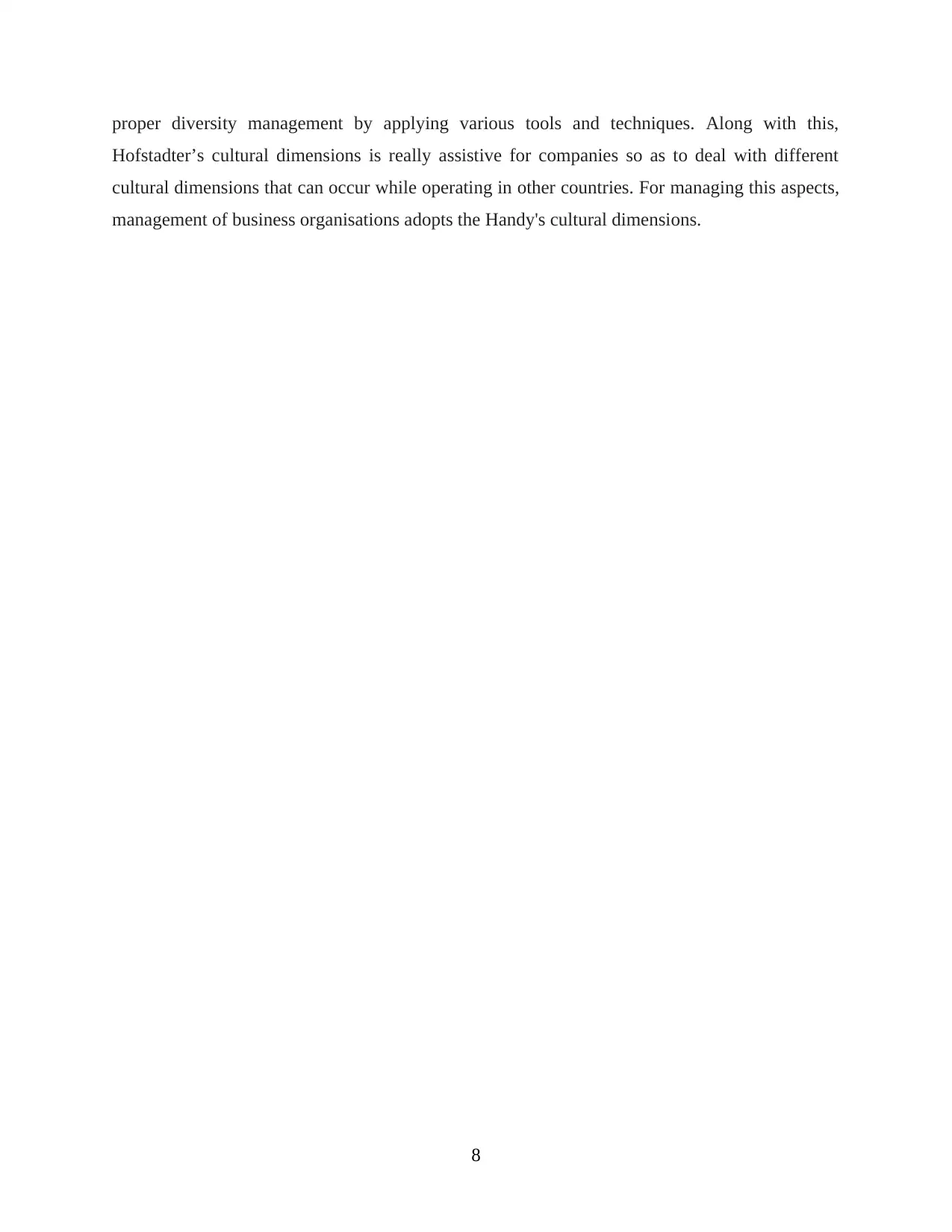
proper diversity management by applying various tools and techniques. Along with this,
Hofstadter’s cultural dimensions is really assistive for companies so as to deal with different
cultural dimensions that can occur while operating in other countries. For managing this aspects,
management of business organisations adopts the Handy's cultural dimensions.
8
Hofstadter’s cultural dimensions is really assistive for companies so as to deal with different
cultural dimensions that can occur while operating in other countries. For managing this aspects,
management of business organisations adopts the Handy's cultural dimensions.
8
Paraphrase This Document
Need a fresh take? Get an instant paraphrase of this document with our AI Paraphraser
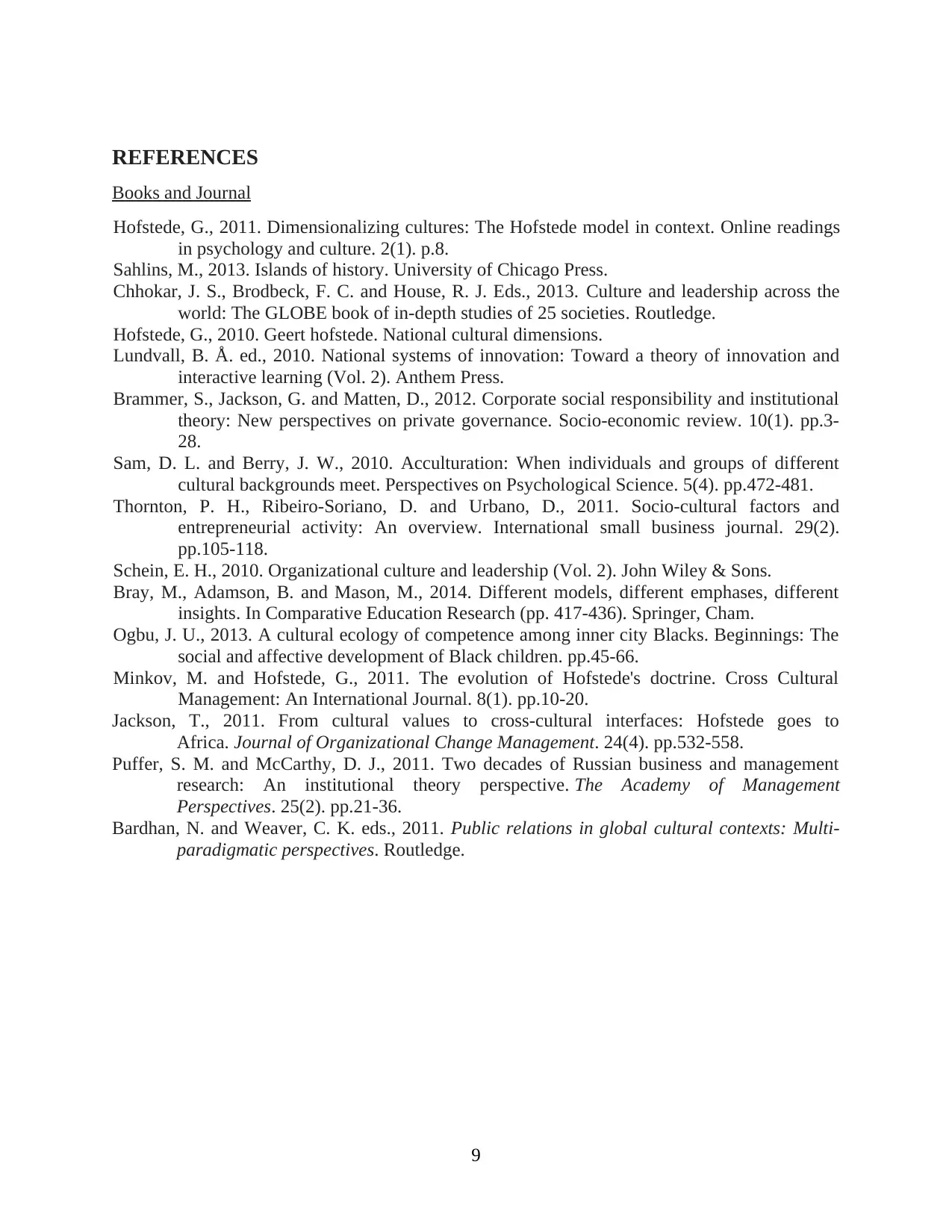
REFERENCES
Books and Journal
Hofstede, G., 2011. Dimensionalizing cultures: The Hofstede model in context. Online readings
in psychology and culture. 2(1). p.8.
Sahlins, M., 2013. Islands of history. University of Chicago Press.
Chhokar, J. S., Brodbeck, F. C. and House, R. J. Eds., 2013. Culture and leadership across the
world: The GLOBE book of in-depth studies of 25 societies. Routledge.
Hofstede, G., 2010. Geert hofstede. National cultural dimensions.
Lundvall, B. Å. ed., 2010. National systems of innovation: Toward a theory of innovation and
interactive learning (Vol. 2). Anthem Press.
Brammer, S., Jackson, G. and Matten, D., 2012. Corporate social responsibility and institutional
theory: New perspectives on private governance. Socio-economic review. 10(1). pp.3-
28.
Sam, D. L. and Berry, J. W., 2010. Acculturation: When individuals and groups of different
cultural backgrounds meet. Perspectives on Psychological Science. 5(4). pp.472-481.
Thornton, P. H., Ribeiro-Soriano, D. and Urbano, D., 2011. Socio-cultural factors and
entrepreneurial activity: An overview. International small business journal. 29(2).
pp.105-118.
Schein, E. H., 2010. Organizational culture and leadership (Vol. 2). John Wiley & Sons.
Bray, M., Adamson, B. and Mason, M., 2014. Different models, different emphases, different
insights. In Comparative Education Research (pp. 417-436). Springer, Cham.
Ogbu, J. U., 2013. A cultural ecology of competence among inner city Blacks. Beginnings: The
social and affective development of Black children. pp.45-66.
Minkov, M. and Hofstede, G., 2011. The evolution of Hofstede's doctrine. Cross Cultural
Management: An International Journal. 8(1). pp.10-20.
Jackson, T., 2011. From cultural values to cross-cultural interfaces: Hofstede goes to
Africa. Journal of Organizational Change Management. 24(4). pp.532-558.
Puffer, S. M. and McCarthy, D. J., 2011. Two decades of Russian business and management
research: An institutional theory perspective. The Academy of Management
Perspectives. 25(2). pp.21-36.
Bardhan, N. and Weaver, C. K. eds., 2011. Public relations in global cultural contexts: Multi-
paradigmatic perspectives. Routledge.
9
Books and Journal
Hofstede, G., 2011. Dimensionalizing cultures: The Hofstede model in context. Online readings
in psychology and culture. 2(1). p.8.
Sahlins, M., 2013. Islands of history. University of Chicago Press.
Chhokar, J. S., Brodbeck, F. C. and House, R. J. Eds., 2013. Culture and leadership across the
world: The GLOBE book of in-depth studies of 25 societies. Routledge.
Hofstede, G., 2010. Geert hofstede. National cultural dimensions.
Lundvall, B. Å. ed., 2010. National systems of innovation: Toward a theory of innovation and
interactive learning (Vol. 2). Anthem Press.
Brammer, S., Jackson, G. and Matten, D., 2012. Corporate social responsibility and institutional
theory: New perspectives on private governance. Socio-economic review. 10(1). pp.3-
28.
Sam, D. L. and Berry, J. W., 2010. Acculturation: When individuals and groups of different
cultural backgrounds meet. Perspectives on Psychological Science. 5(4). pp.472-481.
Thornton, P. H., Ribeiro-Soriano, D. and Urbano, D., 2011. Socio-cultural factors and
entrepreneurial activity: An overview. International small business journal. 29(2).
pp.105-118.
Schein, E. H., 2010. Organizational culture and leadership (Vol. 2). John Wiley & Sons.
Bray, M., Adamson, B. and Mason, M., 2014. Different models, different emphases, different
insights. In Comparative Education Research (pp. 417-436). Springer, Cham.
Ogbu, J. U., 2013. A cultural ecology of competence among inner city Blacks. Beginnings: The
social and affective development of Black children. pp.45-66.
Minkov, M. and Hofstede, G., 2011. The evolution of Hofstede's doctrine. Cross Cultural
Management: An International Journal. 8(1). pp.10-20.
Jackson, T., 2011. From cultural values to cross-cultural interfaces: Hofstede goes to
Africa. Journal of Organizational Change Management. 24(4). pp.532-558.
Puffer, S. M. and McCarthy, D. J., 2011. Two decades of Russian business and management
research: An institutional theory perspective. The Academy of Management
Perspectives. 25(2). pp.21-36.
Bardhan, N. and Weaver, C. K. eds., 2011. Public relations in global cultural contexts: Multi-
paradigmatic perspectives. Routledge.
9
1 out of 11
Related Documents
Your All-in-One AI-Powered Toolkit for Academic Success.
+13062052269
info@desklib.com
Available 24*7 on WhatsApp / Email
![[object Object]](/_next/static/media/star-bottom.7253800d.svg)
Unlock your academic potential
Copyright © 2020–2025 A2Z Services. All Rights Reserved. Developed and managed by ZUCOL.





